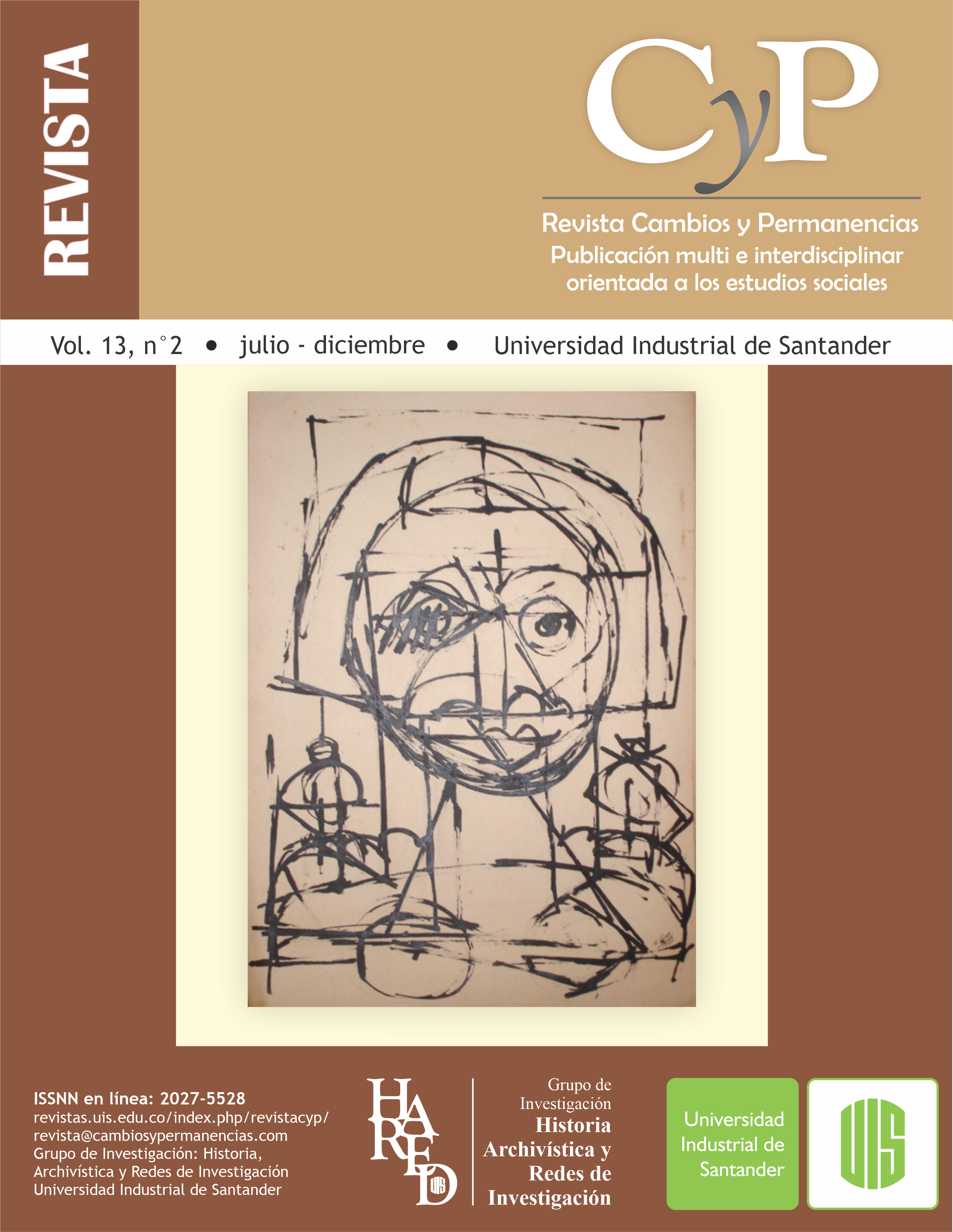Published 2022-11-27
Keywords
- ethnomusicology,
- social network analysis,
- rap,
- complexity
How to Cite
Copyright (c) 2022 Revista Cambios y Permanencias

This work is licensed under a Creative Commons Attribution 4.0 International License.
Abstract
The following study identifies the sociological relationship between social networks and music from an ethnomusicological perspective. In order to achieve this articulation, the collaboration network of the rappers of Cali (Colombia) was identified in the late nineties through Social Network Analysis (SNA) (Borgatti, Everett and Johnson, 2013). The methodological development of this work presents the application of the ARS to a musical case of a collective nature. The results show the character of the network of youth collaborations the lyricists belonging to the hip hop culture and its scene. The analytical premises of the SNA (Watts and Strogatz, 1998; Watts, 2004) allow identifying some of the formal properties of the established network, while the cultural materials acquired through the field work make it possible to establish the level of complexity of the relationship and interactions that the network evidences.
Downloads
References
- Abraham, A., Hassanien A. E. y Snášel, V. (Comps.) (2010). Computational social network analysis: Trends, tools and research advances. Springer Verlag London. https://doi.org/10.1007/978-1-84882-229-0
- Barabási, A. L. (2003). Linked: How everything is connected to everything else and what it means. Plume Books.
- Borgatti S. P., Everett, M. G. y Johnson, J. (2013). Analyzing Social Networks. SAGE.
- Borgatti, S. P., Everett, M. G. y Freeman, L. C. (2002). Ucinet 6 for Windows: Software for Social Network Analysis. Analytic Technologies.
- Bourdieu, P. (1984). Distinction: A Social Critique of the Judgement of Taste. Harvard University Press.
- Cano, P. y Koppenberger, M. (2004). The emergence of complex networks patterns in music artist networks. En Proceedings of the 5th International Symposium on Music Information Retrieval (ISMIR 2004) (pp. 466-469). Instituto Audiovisual, Universitat Pompeu Fabra.
- Cano, P., Celma, O., Koppenberger, M. y Buldú, J. (2006). Topology of music recommendation networks. Chaos: An interdisciplinary journal of nonlinear science, 16(1). https://doi.org/10.1063/1.2137622
- Cheyne, A. y Binder, A. (2010). Cosmopolitan preferences: The constitutive role of place in American elite taste for hip-hop music 1991–2005. Poetics, (38), 336–364. https://doi.org/10.1016/j.poetic.2010.01.001
- Clarke, E. y Cook, N. (Eds.) (2004). Empirical Musicology Aims, Methods, Prospects. Oxford University Press. https://doi.org/10.1093/acprof:oso/9780195167498.001.0001
- Clayton, M., Sager, R. y Udo, W. (2004). In Time with the Music: The Concept of Entrainment and its Significance for Ethnomusicology. ESEM Counter Point 1.
- De Nora, T. (2004). Historical perspectives in music sociology. Poetics, (32), 211–221. https://doi.org/10.1016/j.poetic.2004.05.003
- DiMaggio, P. y Mukhtar, T. (2004). Arts Participation as Cultural Capital in the United States, 1982–2002: Signs of Decline? Poetics, (32), 169–94. https://doi.org/10.1016/j.poetic.2004.02.005
- García Barrientos, J. L. (2000). Las figuras retóricas. El lenguaje literario 2. Arco Libros.
- Guzmán, Á. (1999). Violencia urbana y pobreza. En F. Urrea, y C. H. Ortiz. (1999). Patrones sociodemográficos, pobreza y mercado laboral en Cali (pp. 45-56). Documento elaborado para el Banco Mundial.
- Hage, P. y Harary, F. (1995). Eccentricity and centrality in networks. Soc. Netw, (17), 57–63. https://doi.org/10.1016/0378-8733(94)00248-9
- Headland, T., Pike, K. y Harris, M. (Comps). (1990). Emics and Etics: The Insider/Outsider Debate. Sage Publications.
- Hormigos, R. J. (2012). La sociología de la música. Teorías clásicas y puntos de partida en la definición de la disciplina. BARATARIA. Revista Castellano-Manchega de Ciencias Sociales, (14), 75-84.
- Informe de Organismos no Gubernamentales de Derechos Humanos. (1996). A lo bien, Parce. [Documento de trabajo].
- Kochen, M. (Ed.). (1989). The Small World. Ablex.
- Koelsch, S. (2015). Music-evoked emotions: principles, brain correlates, andimplications for therapy. Annals of the New York Academy of Sciences, 1337(1), 193–201. https://doi.org/10.1111/nyas.12684
- Li, T., Ogihara, M. y Tzanetakis, G. (Eds). (2012). Music Data Mining. CRC Press, Taylor & Francis Group.
- Liu, X. F. y Tse, M. C. K. (2010). Small, Complex network structure of musical compositions: algorithmic generation of appealing music. Physica A., 389(1), 126–132. https://doi.org/10.1016/j.physa.2009.08.035
- Lomax, A. (1977). Appeal for Cultural Equity. Journal of Communication, (Spring) (27), 125-138. https://doi.org/10.1111/j.1460-2466.1977.tb01838.x
- Luján, J. D. (2015). Etnomusicología de las músicas turbias: consumos culturales, raza y etnicidad. Esfera, 5(1), 5-20.
- Miceli, J. (2011). Alcances y límites del ARS en la actualidad: reflexión sobre tres extensiones deseables para análisis reticular. Hallazgos, (15), 19-38.
- Milgram, S. (1967). The small world problem. Psychol. Today, (2), 60–67.
- Newman, M. (2001). I Represent Me: Identity Construction in a Teenage Rap Crew. Texas Linguistic Forum, 44(2), 388-400.
- Peterson, R. A. (2005). Problems in Comparative Research: The Example of Omnivorousness. Poetics (33), 257–82. https://doi.org/10.1016/j.poetic.2005.10.002
- Reynoso, C. (2011). Redes sociales y complejidad: Modelos interdisciplinarios en la gestión sostenible de la sociedad y la cultura. Sb.
- Ritossa, D. A. y Rickard N. S. (2004). The relative utility of “pleasantness" and “liking" dimensions in predicting the emotions expressed by music. Psychology of Music, 32(1), 5-22. https://doi.org/10.1177/0305735604039281
- Singer, P. (2000). Una izquierda darwiniana. Política, evolución y cooperación. Crítica.
- Stephens, R. J. y Wright II, E. (2000). Beyond bitches, niggers, and ho’s: some suggestions for including rap music as a qualitative data source. Race & Society, (3), 23–40. https://doi.org/10.1016/S1090-9524(01)00019-5
- Taleb, N. N. (2008). El cisne negro. El impacto de lo altamente improbable. Paidós.
- Toynbee, J. (2003). Music, Culture, and Creativity. En M. Clayton, H. Trevor y R. Middleton (Eds.), Cultural Study of Music a critical introduction (pp. 106-116). Routledge.
- Vander-Stichle, A. y Laermans, R. (2006). Cultural Participation in Flanders: Testing the Culture Omnivore Thesis with Population Data. Poetics (34), 45–56.
- Watts, D. (2004). The ‘new’ science of networks. Annual Review of Sociology, (30), 243-270. https://doi.org/10.1146/annurev.soc.30.020404.104342
- Watts, D. y Strogatz, S. (1998). Collective dynamics of ‘smallworld’ networks. Nature, 393(6684), 440–442. https://doi.org/10.1038/30918
